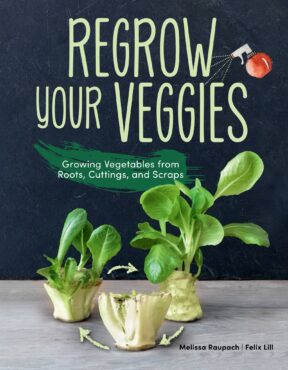 Editor’s note: This is an excerpt adapted from the book “Regrow Your Veggies: Growing Your Vegetables from Roots, Cuttings, and Scraps,” recently published by CompanionHouse Books.
Editor’s note: This is an excerpt adapted from the book “Regrow Your Veggies: Growing Your Vegetables from Roots, Cuttings, and Scraps,” recently published by CompanionHouse Books.
Living in a globalized world has many advantages. Of course, transporting people and goods is much quicker, but also knowledge, culture and other perspectives cross borders more easily than anyone could have imagined a few decades ago. With all the advantages that globalization brings developed countries and its citizens, it’s also important to consider its negative effects.
Unfortunately, the mantra of “higher, further, faster” often comes at the expense of humans, animals and the environment. Even though globalization is irreversible, it is not (yet!) set in stone how we, humans in industrialized nations, will pave the way for the future. Taking care of our planet and its resources is, in my eyes, one of the greatest challenges of today’s generations.
Even if that sounds like a ton of responsibility at first, anybody can contribute their part by living a more sustainable lifestyle. Hardly any other thing out there lends itself better to this goal than changing personal consumption behavior. Whether it’s the clothes you wear or the electronic devices you use, purchasing behavior influences both supply and demand.
 An example of this is the increasing number of vegan and vegetarian products in supermarkets, cookbooks and restaurants. It’s not about giving something up, but about consciously choosing to consume more sustainable products.
An example of this is the increasing number of vegan and vegetarian products in supermarkets, cookbooks and restaurants. It’s not about giving something up, but about consciously choosing to consume more sustainable products.
Another important issue that is closely related to our consumer behavior is the garbage it produces. In a recent study, a whopping yearly average of 940 pounds of household waste (and not including large items like electronics) were measured — way too much! Making a conscious decision in this regard can also really make a difference.
One way, for example, is by recycling. Much of what is carelessly thrown in the garbage can be used reused. From pickle jars to shoe boxes, with a bit of creativity and ingenuity, these objects can be given a new life; not to mention, it saves you money.
Living Sustainability by Regrowing Vegetables
With the internet and many social media channels full of do-it-yourself inspiration, those of us who aren’t as creative can easily find very detailed instructions on being better recyclers. Recycling can, therefore, be seen as the alternative to a “disposable” lifestyle — and the same can be said of regrowing unused vegetables.
By regrowing, you’re reducing household waste and providing fresh food at the same time. You probably won’t be able to replace your entire produce consumption with regrown vegetables (unless you don’t eat a lot of vegetables or you’re a real regrow pro). But that’s not the goal. Rather, it’s about returning to simplicity.
 This is closely related to the current “zero waste” trend. This global movement doesn’t just recycle waste, but attempts to avoid it altogether. The principles of zero waste are known as the five Rs: refuse, reduce, reuse, recycle and rot.
This is closely related to the current “zero waste” trend. This global movement doesn’t just recycle waste, but attempts to avoid it altogether. The principles of zero waste are known as the five Rs: refuse, reduce, reuse, recycle and rot.
Some of the zero-waste pioneers out there produce in a whole year only enough waste to fit inside a small jam jar. Although you can’t make such an extreme change overnight, it is still a good idea to pay attention to your consumption habits and reduce waste wherever possible.
By regrowing vegetable waste, vegetables are not only reused, but organic waste and the carbon footprint associated with transporting it in garbage trucks are also reduced. Creating a new life out of organic waste is a return to the natural circle of life. Aside from the ethical motivations, it’s also a lot of fun to hone your skills as a regrow gardener.
Vegetable Propagation: Turning One Into Many
When regrowing plants, you have to distinguish between generative and vegetative propagation. Both types occur naturally in nature and play a role in regrowing.
Plants primarily use their seeds to create the next generation. Pollen (the “male,” if you will), comes in contact with the stigma (the “female”). This process is called generative or sexual reproduction in plants. Vegetation like avocados and mangoes grow out of their seeds and are, therefore, generative.
When plants reproduce without seeds, it is called vegetative propagation. Using discarded parts of vegetables to grow new ones falls into this type of plant reproduction.
Vegetative propagation works very differently than generative propagation. Since a part of the mother plant is used to grow a new plant from it, this process is known as asexual reproduction.
Those reading carefully may have noticed a key distinction: The mother plant and the offspring have the same genes because the mother is able to create offspring without fertilization. Therefore, the regrown plants are direct clones of the mother plant.
 But don’t worry, your house isn’t going to turn into the set of a science fiction movie. For plants in the wild, this process of propagation happens naturally every day. Still, it might sound strange to clone your vegetables for fun because this would be morally unimaginable for animals and humans (and rightfully so).
But don’t worry, your house isn’t going to turn into the set of a science fiction movie. For plants in the wild, this process of propagation happens naturally every day. Still, it might sound strange to clone your vegetables for fun because this would be morally unimaginable for animals and humans (and rightfully so).
Many green thumbs have been using this method of vegetative propagation for a long time. The concept is pretty interesting: Let’s say you have a favorite plant in your garden that bears perfect fruit. With vegetative propagation, you can make a perfect clone of it with the exact same characteristics.
The asexual form of reproduction is a true miracle of nature. Isn’t it crazy to think that you can cut off a piece of a vegetable and grow an entirely new one from it? This is possible because each individual plant cell contains all of its genetic material. That means, for example, that a cell in a stalk of romaine lettuce has the same amount of genetic information as a cell from its roots or leaves. The technical term for this is totipotent.
With regrowing, the cells reprogram themselves to take on new roles inside the plant. This process is what enables regrowing to work. The reprogramming of cells works especially well with young and fresh plants. Consider this when choosing your regrow veggies.




























